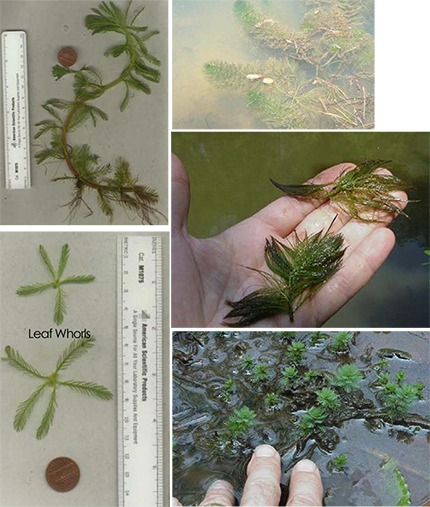Submerged Aquatic Vegetation (SAV) Identification Key
Main_Content
The bay grass key was designed to allow you to identify most species of bay grasses found in Maryland. Although bay grasses are notoriously difficult to identify using standard taxonomic keys, the flexible format of the Internet allows us to combine detailed pictures, simple line drawings and text messages in a stepwise sequence that makes identifying bay grasses simple. You may find it useful to have a clear metric ruler with millimeters marked, a magnifying glass, and a Ziploc plastic bag to help you in the process of identifying your plant.

|
If you already know the identity of a particular bay grass use the drop down boxes below. |
|---|
Common Name:
or
Scientific Name:
| | Common Name: | Parrot Feather, milfoil |
| | Scientific Name: | Myriophyllum brasiliense (or aquaticum) |
| | Native or Non-native: | Non-native
|
| | Illustration: | 
|
| | Link to larger illustration: | |
| | Printable Version: | |
| | Family: | Hydrocharitaceae |
| | Distribution: | Parrot feather is a herbaceous aquatic perennial that gets its name from the feather-like appearance of its gray-green leaves. Male and female flowers are on different plants, but only the female plants have been found in North America. Parrot feather is a native of the Amazon River and was introduced to North America in the Washington, D.C. area around 1890. However, since its introduction, the plant has spread throughout the southern United States. It is found in non-tidal fresh waters, where it can quickly spread to cover available habitat. It has not been reported in tidal waters and its salinity tolerance is not known. |
| | Recognition: |
Plants are reddish tinted with bright green growing tips. Very leafy foliage on stout stems that often emerge a few inches above water (emergent tips appear gray-green). Leaves occur in whorls of mostly 5, all alike, 2-5 cm (< 3/4 in to 2 in) long with 10-25 hair-like segments per side. Bracts are leaf-like, with filiform bracteoles (thread-like leaves) cleft into 2 or 3 divisions. Parrot feather bears fruits that are 2 to 3 mm (1/16 in) long, and finely granular. |
| | Ecological Significance: | Parrot feather can grow in many different water habitats, but grows best in deeper, nutrient-rich environments. Parrot feather can spread and grow very quickly, which can have adverse effects on the body of water it is in, such as inhibiting water flow, and reducing the amounts of dissolved oxygen in the water which can be harmful for fish. Also, since it can spread so quickly, it can outcompete other SAV like pondweeds and coontail which are good sources of food for waterfowl. |
| | Similar Species: |
Parrot feather usually has whorls of 5 pinnate leaves, whereas Eurasian watermilfoil ( Myriophyllum spicatum) usually has whorls of 4 pinnate leaves and only its flowers stick above the water. Appearance is similar to coontail (Ceratophyllum demersum); coontail, however, has whorls of 9-10 leaves at stem nodes, lacks a root system and never protrudes above the water surface. |
| | Reproduction: |
Reproduction is both sexual (by seed) and asexual (by fragmentation). Parrot feather is dioecious with unisexual flowers, which form in the axils (the angle between the upper side of the leaf and the stem) of submerged leaves.
|
|
|
Center_Content
For permission to reproduce individual photos, please contact Mike Naylor
The text and photos used in this key were produced through a collaborative effort among the following partners.

